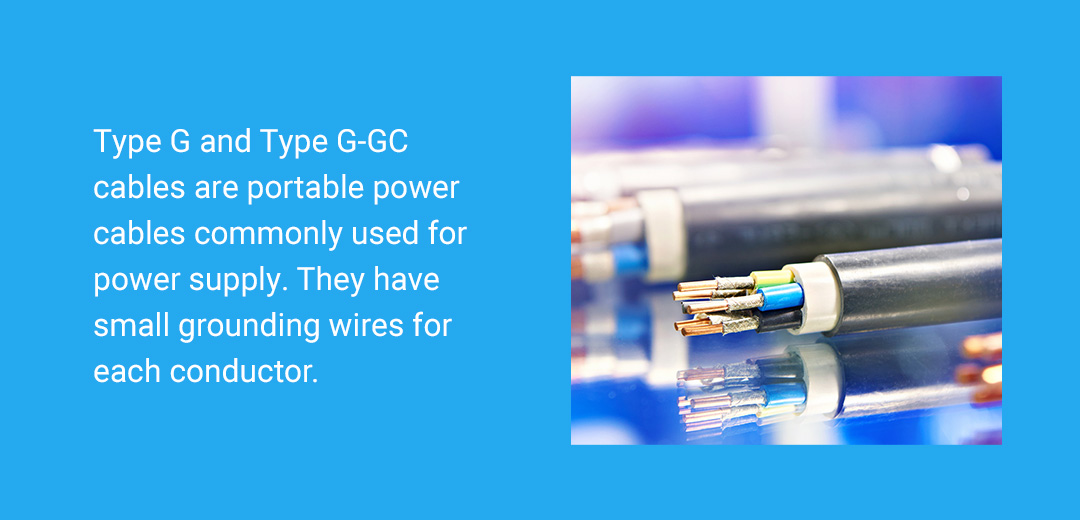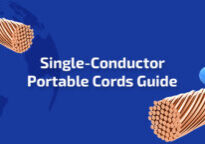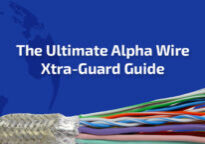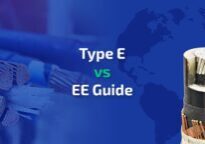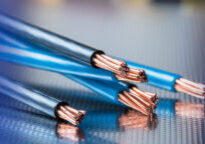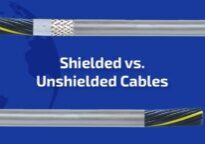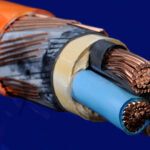
Feb 16, 2023
Type W vs. Type G Cables
The Type W and Type G power cables are very similar. These industrial-strength power cables suit nearly the same applications. They can be used in many homes and job sites to power machinery.
Both cable types have 2,000-volt-rated rubber insulation. They are rugged enough to be run over by trucks and dragged across rocky areas. Despite their many resemblances, these cables differ in a couple of areas. Explore the differences between Type W and Type G power cables.
What Is Type W Cable?
Type W cables are durable, portable power cords. Multi-conductor Type W cables are suitable for temporary power supply applications, while single-conductor cables can provide permanent power supply. With multiple sizes and protective features, these versatile cables accommodate a variety of heavy-duty environments.
Type W cables can include up to five conductors. They have no additional ground wires. There is a same-size green wire in three conductor cables and higher, and the different colors help identify each wire.
This cable type is an industrial power cable as small as 8 American Wire Gauge (AWG) and as large as 500 thousands of circular mils (MCM) with three conductors. Type W comes in 2,000 volts with the same rubber ethylene propylene diene monomer (EPDM) jacket and flexible copper strands. The type W power cable 8 AWG with three conductors carries 74 amps, while the SOOW 8 AWG with three conductors only carries 40 amps. Industrial power cables have much thicker insulation for higher voltage and higher ampacities.
Type W comes with one, two, three, four or five conductors, and one will be green to act as a same size ground wire. There are not any additional ground wires in Type W cable. Type G and G-GC cables come with additional ground wires if you need them for your application.
Applications for Type W Cable
Type W cables deliver reliable performance in demanding environments, making them ideal for applications where they could get rolled over or stepped on. Unlike Type G cables, Type W power cables have a single-conductor feature, equipping them for a broader range of portable power applications.
All the robust materials in Type W cable’s construction make it extremely flexible without sacrificing durability, so it’s easy to move around for portable applications in rough environments. Here are some common uses for Type W power cables:
- Light- to medium-duty mining applications
- AC systems
- Temporary power for mobile and portable electronic equipment
- Permanent wiring for heavy equipment
- Warehouse power supply
- Welding applications
- Entertainment industry applications (spotlights, stage lighting, video systems, mobile communications vans, sound systems, etc.)
The cable’s rubber jacket can withstand severe environmental conditions and exposure to oils, acids, alkalis, heat, moisture and most chemicals. This cable really can handle anything, making it perfect for messy and hazardous industrial settings.
Similar Cable Types
If Type W doesn’t sound right for your application or you’re looking for something more cost-effective, we sell many other types of power cables, such as:
- Welding cable. Welding cable is similar to Type W cable, with high durability and versatile sizing. It supports up to 600 volts.
- Type G and GC. These cables aren’t available in as large a size range as Type W, but they offer similar characteristics and are rated for direct burial applications. Type G cables have a ground wire for every conductor and Type G-GC cables have an additional ground-check wire.
We also stock diesel locomotive (DLO) cable, stage lighting cables and other portable power cord cables.
What Are Type G and G-GC Power Cables?
Type G and Type G-GC cables are portable power cables commonly used for power supply. They have small grounding wires for each conductor. If there are three main conductors, there are also three smaller ground wires. If there are four main conductors, there are four smaller ground wires.
The “GC” stands for “ground check.” The G-GC cables are known for having excellent impact resistance. They are made with a cable core bound for superior flexibility and toughness. They also have a rope lay stranding to maximize the cable’s flex life.
While Type G and G-GC cables are mostly identical, one characteristic sets them apart. Type G power cables have four conductors and four green ground wires. Meanwhile, Type G-GC power cables have one yellow ground check and two green ground wires, which grow in size as the cable increases in American Wire Gauge (AWG). They have three conductors with three additional ground wires.
The ground check is a built-in safety mechanism to ensure the equipment is completely grounded. The “G” in Type G indicates it only has ground wires, while G-GC means “ground with ground check.”
Type G-GC is a 2,000-volt power cable that comes with three conductors with three additional ground wires only. There will be three conductors in the same size with one yellow ground check and two green ground wires. These get slightly larger as the cable gets higher in AWG size.
Type G is a four-conductor industrial power cable with four green ground wires. All of the Type W and Type G cables can withstand up to 90 degrees Celsius, and all of the ground wires are insulated with premium-grade EPDM rubber insulation. They’re resistant to abrasion, oils, alkalies, heat, moisture and most chemicals. They’re UL, CSA, MSHA and RoHS compliant.
Type G and G-GC Power Cable Applications
Types G and G-GC power cables provide temporary portable power in industrial applications. Some typical uses for these cables include mining pumps and equipment, conveyors, shuttle cars and heavy-duty power supply cables.
They’re instrumental as power supply cables requiring grounding. Additionally, they’re ideal where a ground check conductor is needed for ground monitoring.
What’s the Difference Between Type W and Type G Power Cables?
The ground wires are the main difference between Type W and Type G power cables. The Type W cables do not have additional ground wires, while the Type G cables do. The wires inside the cable are colored and have numbers imprinted on them to indicate conductor and ground wire specifications.
Other than the ground wires, these cables are generally very similar. As mentioned, they both have a voltage rating of 2,000. They’re both considered some of the sturdiest industrial power cables on the market. Here are some other similarities between them:
- Rated for temperatures of minus 40 to 90 degrees Celsius
- Premium-grade EPDM rubber insulation
- Compliant with most United States industry standards, including Canadian Standards Association Group, Underwriters Laboratories, Restriction of Hazardous Substances, and Mine Safety and Health Administration
- Suitable for heavy-duty applications, like oil drilling platforms, mining equipment, electrical equipment, motors and batteries
- Ideal for water submersion and industrial marine applications
- Sturdy rubber jackets resistant to air, weather, abrasion, UV light, fire, oil, water, mechanical impact and industrial chemicals
- Fully annealed, flexible copper strands
What’s the Difference Between Type W, Type G and SOOW Cables?
Another type of multiconductor portable cord is SOOW. SOOW cables are service cables with oil-resistant insulation and jackets. They are water-resistant and provide 600 volts compared to the 2,000 volts Type W and Type G options support. Because of the higher volt rating, Type W and Type G have thicker jackets made of premium-grade EPDM. SOOW cable is made with flexible copper conductor strands like these other cable types are and also features EPDM jackets.
Like Type W and Type G, SOOW cables are rated from temperatures between minus 40 degrees Celsius to 90 degrees Celsius. You’ll find conductors in SOOW cable ranging from two to 60. Unlike Type W and Type G cables, SOOW options are available in a smaller size range, from 2 AWG to 18 AWG. Ampacities reach as high as 95 on SOOW 2/3 cables.
Type W cables are more often used in heavy-duty industrial applications and are essentially a tougher, more flexible SOOW cable. SOOW cables are still robust but are used in smaller applications.
SOOW cables are more similar to Type G and Type G-GC options in their applications. As portable cables, SOOW wires work well for mobile equipment or tools in both indoor and outdoor uses when appropriately rated. In industrial projects, SOOW cables are practical for motors, mining equipment, construction equipment and locomotives. You can also use SOOW cords in commercial and residential projects, like fire alarms, battery chargers, remote controls, and portable tools and lighting systems.
It is also useful to know about service, junior, oil-resistant and water/weather-resistant cables, called SJOOW. SJOOW cables are similar to SOOW options but only support 300 volts, making them ideal for small-scale projects that still require robust cords.
Order Your Power Cables From WesBell Electronics Today
Whether you need Type W, G, G-GC, SOOW or SJOOW cables for your next wiring project, you can find the solutions you need at WesBell Electronics. We’re your one-stop shop for bulk cable, wire and tubing products, providing off-the-shelf and custom order options.
We also offer various wire preparation services, including cutting, twisting, harness assembly and more, helping you save time and money in production. If you’re unsure what cable type your project requires, our experienced technicians are happy to help you out.
Our knowledgeable team works hard to offer customers the best service possible, providing free shipping on orders over $500, cutting exact product lengths for your needs and offering quick turnaround times. When you choose WesBell Electronics for wire products and preparation, you’ll receive outstanding service from knowledgeable representatives. Check out our available Type W and G power cables, or contact our team with any questions!


